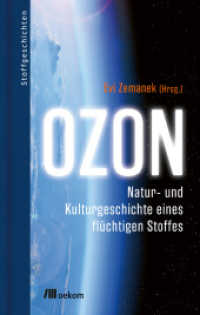- ホーム
- > 洋書
- > ドイツ書
- > Social Sciences, Jurisprudence & Economy
- > Politics, Society, Work
- > social science
Full Description
Kurdish memories of the Armenian Genocide challenge the systematic denialism established by the Turkish state structures and foster new possibilities of coming to terms with the past. This book examines Kurdish biographies, especially from Van, Turkey, and explores the dynamics of intertwined remembrance regimes concerning the political violence on Armenians and Syriac Christians of Ottoman imperial subjects and on Kurdish citizens of Turkey. These life stories shed light on the complexity of remembering, including collective and individual memory notions on violence, perpetratorship and victimhood from past and present.
The author focuses on the Kurdish collective and individual memories through reconstructing biographical narrative interviews and ethnographic data. Based on such empirical inquiry, Yetkin argues that the genocide memory helps the Kurdish society articulate, describe, and discuss its own experiences with the state and political violence.
Thus, denialism as a systematic notion by the Turkish state apparatus appears to be read accurately when the ongoing state violence on Kurds is problematised parallelly. Alternative younger voices questioning the forefathers' involvement in the persecution have repeatedly confronted Kurdish positions in politics and civil society fostering critical discussions on the past - underscoring reconciliation with Armenians yet employing anachronistic patterns of storytelling. They have opened up new trajectories based on their experiences.
Hence, the author understands the situation as a multi-faceted and multi-layered memory complexity that contains interwoven narratives starting the Kurdish social time with the genocidal violence on Armenians and Syriac Christians of the region and pointing out continuous oppression. In short, a sphere of contested and multidirectional memories challenging foundations of denialism and settled stories emerges within this context and makes the Kurdish experiences discussable.
Contents
From the Contents
1. INTRODUCTION
1.1. ACCESS TO THE FIELD AND RESEARCH PROCESS
1.2. RESEARCH ETHICS
1.3. OUTLINE OF THE STUDY
2. RESEARCH DESIGN
2.1. FOCUSED ETHNOGRAPHY
2.2. BIOGRAPHICAL RESEARCH
2.2.1. Biographical Narrative Interviews: Overview of some Terms
2.2.2. Data Collection
2.2.3. Analysis
2.3. RESEARCH QUESTIONS
3. STUDYING MEMORY: APPROACHES, CONCEPTS, AND COMPLEXITIES
3.1. CONCEPTUALISING MEMORY
3.1.1 Violence in Processing
3.2. CONTESTED MEMORIES
3.3. CONCLUDING REMARKS
4. ARMENIAN GENOCIDE AND THE TALE OF VAN
4.1. A BRIEF INTRODUCTION TO THE CONTEXT
4.1.1. History of Histories
4.2. VAN
4.2.1. Towards the Van Resistance
4.2.2. Resistance of Van and Mass Destruction of the City
4.2.3. Post-1915 Van and Violence Afterwards
4.3. NAMING THE CONTEXT IN (POST-)VIOLENCE AND STRUGGLE FOR THOSE LEFT BEHIND
4.3.1 Subjectivities
4.4. 1915 ALONGSIDE HISTORIOGRAPHY
4.5. CONCLUDING REMARKS
5. THE CONFLICT OF RECOGNITION AND DENIAL
5.1. ON DENIALISM (OF THE ARMENIAN GENOCIDE)
5.1.1. The brief chronology of the Armenian Genocide Denialism
5.2. THE CONTEMPORARY SITUATION IN THE "WEST"
5.2.1. Just Memory. A novel approach?
5.2.2. On the field with events
5.2.3. Brief Excursion to Social Media and Political Engagement
5.2.4. The "Depo(t)" for counter memories
5.3. CONTEMPORARY SITUATION IN VAN
5.3.1. The War as the Context
5.3.2. Denialism as the Context: Memorial Site of Zeve
5.3.3. Collective Memory on the Armenian Past, Genocide and Violence in Van
5.4. RECOGNITION DEBATE(S) AMONG KURDS IN TURKEY
5.4.1. Actors and Political Positions
5.4.2. Reflections in the Kurdish Society or Scholarship
5.5. CONCLUDING REMARKS
6. LIFE STORIES. RECONSTRUCTING BIOGRAPHICAL EXPERIENCES AND MEMORIES
6.1. MEHMED
6.1.1. Analytical Abstraction
6.1.1.2. Biographical Synopsis
6.1.1.2. Elements of Violence in Narration
6.2. DELAL
6.2.2. Analytical Abstraction
6.2.2.1. Biographical Synopsis
6.2.2.2. Elements of Violence in Narration
6.3. ZAL
6.3.1. Analytical Abstraction
6.3.1.1. Biographical Synopsis
6.3.1.2. Elements of Violence in Narration
6.4. CONCLUDING REMARKS
7. VIOLENCE AND GENOCIDE IN MEMORY. A COMPARATIVE DISCUSSION
7.1. SEMANTICS OF VIOLENCE. HOW TO DESCRIBE, WHAT TO DISCUSS
7.1.1. Mnemonics: Space and Material
7.1.2. Protagonists
7.1.3. Collective References: Outlines and Frames
7.1.3.1. Idealising the Past and Victims
7.1.3.2. Narrative of Instrumentalisation and Victimhood
7.2. CONTINUITY OF VIOLENCE AND TEMPORAL QUESTIONS
7.2.1. Anachronisms and Analogies
7.2.2. Generational Questions
7.2.3. Envisioned Futures
7.3. THE CONTESTED AREA AND THE SELF
7.3.1. Memory in Transition
7.4. CONCLUDING REMARKS
8. CONCLUSION
NOTES
REFERENCES








